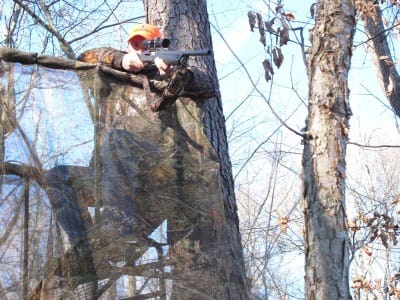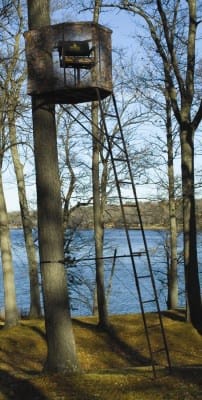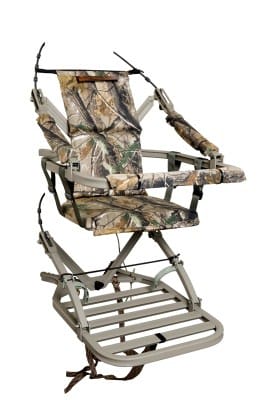
Next to a hunter’s gun, bow and camouflage, a treestand has become as much a part of a deer hunter’s “essential” gear as anything else you will find on a sporting goods retailer’s shelves. While Western guys are still fond of their spot-and-stalk methods, and you will still find plenty of sportsmen who argue they are fine just sitting on the ground or utilizing the old school method of still hunting, perching among the limbs of a tree along a likely ambush spot remains the best opportunity for many of us to kill a whopper buck.
But unlike the old days when our only choice was to grab an armload of 2x4s and construct a ladder and a platform in a tree, today hunters have numerous choices for elevating their chances for deer hunting success. Following is a look at the most common types of stands available along with the benefits and drawbacks of each depending on your hunting style and land situation.
Ladder Stands
By far one of the easiest types of treestands to climb, today’s metal ladder stands are a close cousin to the old homemade ladder stands many of us grew up hunting in. These stands are great for perennial field edge or near-the-path locations that you’ll hunt over and over, but because of their unassembled bulk and multiple pieces, you won’t want to move them much during the season, nor will you want to carry them far through the woods. Once they’re up though, you have to love them. When it’s time to hunt, you simply walk to the stand and climb in it. Most models will put as high as 12 to 16 feet, with some going as far up as 20 feet. That’s plenty high enough for the average hunter to escape a deer’s detection. According to Southwick Associates’ Huntersurvey.com, the hunting industry’s most comprehensive monthly survey of hunter buying habits, nonclimbing stands such as ladders accounted for more than 35 percent of all stands, blinds and related accessories purchased so far this year.
Benefits
- Easy and among safest to climb
- Usually not too high, adding to safety
- Can support larger platform for more comfort and to hold as many as two people
- Safest, most secure option for kids
- Ideal for locations you will hunt repeatedly, particularly near fields and trails
- Trees don’t need to be straight and can have limbs low to the ground

Drawbacks
- Heavier and bulkier to carry, especially spots far from path
- Generally takes two people to set up
- Can’t take down and move as easily for setup changes during the season
- Limited height for hunters who like to climb high
- Because of their size, they stand out more in the woods
Hang-On Stands
Long a popular choice among serious hunters, hang-on stands are the lightest, most compact, easy-to-tote stand type there is making them great for setups far from the beaten path. Consisting of a mere platform, brace and fold-out seat, they are easy to carry and most models can be safely hung on any type of tree at least 10 inches in diameter. Because they are not attached to a ladder, hunters can use screw-in steps or strap-on climbing sticks to hang a stand as high as their hunting situation dictates. Seating and platform sizes have come a long way in recent years making these once less-comfortable stand options now more pleasing to sit in. However, because they typically are still very compact and require narrow climbing sticks or precariously screwed in pegs to get to them, these stands are not for the faint-of-heart or those with height issues.
Benefits
- Lightest, most compact treestand type
- Can hang in any type of suitably sized tree regardless of low limbs
- Can hang as high or low as the hunter is comfortable
- More easily concealed among limbs and leaves of tree
- Easier to setup than a larger ladder-type stand
- Compact size makes them ideal for spots far from path
- Most affordable stand option
Drawbacks
- Can be precarious to access
- Not so easy to hang that you will want to move often
- Can only seat one hunter
- Usually no rail for added safety (but is great for bowhunting because of this)
- Smaller size usually translates into less comfort, particularly for larger hunters
- Need to purchase screw-in or strap-on steps in addition to stand
Climbing Stands
If you hunt an area with ample mature, straight trees and like to change your hunting setups constantly, then a climbing stand is for you. Mike Mattly, head of public relations at Summit Treestands (www.summitstands.com), says his company sells far more climbers than any other type of stand that they make-and they make them all. This despite Southwick’s Huntersurvey.com revealing that industry wide, only 12.4 percent of hunters claiming to have bought a treestand, blind or related accessories this year said they purchased a climbing stand. But for quick-strike hunters looking to make one trip in, hunt and then get out, they can’t be beat. There is no need to go in before you hunt to hang the stand, the drawback being of course, that you may make a little more noise going up a tree with a climber than you would going up a stand that is already hung. Modern climbing stands are engineering marvels with safety, silence and comfort all taken into account.
Benefits
- Doesn’t require setup prior to hunting
- Can change setup anytime, anywhere with ease
- Climbing height is limited only by the height of the lowest limbs on the tree
- Lightweight and easy-to-carry (usually with backpack-type straps)
- Enables stand hunting far from trails and paths

Drawbacks
- Bulkier to carry than a hang-on
- Requires trees with straight trunks and without low limbs
- Requires more physical exertion to ascend and descend
- Not as practical for hunting same spot repeatedly
- Can only seat one person, poor choice if filming hunt with a partner
- Generally more expensive than ladders or hang-ons
Finally, remember, regardless of which stand you choose to hunt from, always wear a safety harness. Nobody plans to take a fall, but bring the topic up in camp, and you’ll be amazed at the number of guys who admit to having close brushes with a dangerous plunge. There’s just no reason to take that chance.
Tower Stands
Got no trees? Then a tower stand is your best in-the-sky option. These stands typically employ a tripod-type system that may include only a chair and small platform at the top or may boast an entire pod in which a hunter can sit. If using the latter, this is ideal for rainy day setups, though I’ve been in some that if the wind picked up, I got down real quick. Because of their size and design, these stands are generally much more expensive, too, which may keep some hunters on the ground or waiting for the trees in a planted cutover to mature.
Safety First
Regardless of what treestand type you use-or if you use a combination of all three like I do-always wear a safety harness. Hunter Safety Systems (www.huntersafetysystem.com) and Summit’s Seat-O-The-Pants (www.summitstands.com) are two of my favorite options available today. Both of these companies’ harnesses provide full support of the upper and lower body to minimize breathing issues caused by uneven body support should you fall and find yourself hanging around for awhile. And while it may seem like a hassle, wear that harness while climbing up and down the tree, not just once you’re in the stand. One study from years ago found that more than 70 percent of falls occurred while the hunter was ascending or descending a stand.



